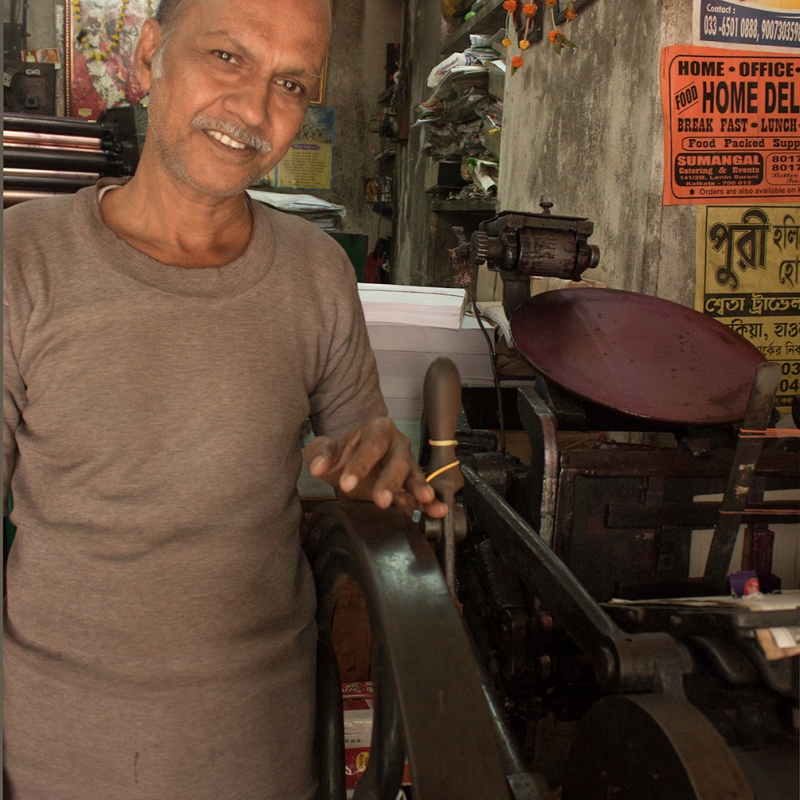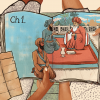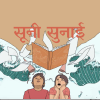Colonial Calcutta is often described in terms of the duality of the ‘black’ and ‘white’ towns—the ‘native’ quarters, with its cramped streets and bustling bazaars, and the ‘sahib’ quarters (the area between Chowringhee Road, Park Street, Theater Road, and Wood Street) with wide roads and neo-classical architecture. The attempts by colonial town planners to impose a certain order and familiarity for the white occupants of the city—through the widening of roads, landscaping, or through the construction of ‘wrought-iron railings, masonry walls, and gates’ (Chattopadhyay 2005:92)—could not, however, contain the heterogeneity of 19th-century Calcutta. European-owned businesses spilled over to the streets of the ‘native town’, while it was possible for wealthy Indians to own property in the so-called ‘white town’. The city was divided into paras, tolas, and tulis—suffixes that still serve as markers of locality in present-day Kolkata. Criss-crossed by narrow alleys and bazaars, leading up to the riverfront and the ghats—centres of commerce and spirituality at once—it took on a life of its own, independent of the best intentions of the town-planners. The print industry that evolved in the city in the early decades of the 19th century retained this heterogenous character of the city.
Printing Presses and Publishers
The earliest printing presses of colonial Calcutta emerged in the 1770s, owned by European printmakers. Nathaniel Brassey Halhed published his A Grammar of the Bengal Language, the first printed book to have been published with a Bengali typeface in 1778, in a printing press in Hooghly, the erstwhile Portuguese town across the river from Calcutta. The Bengali typeface, the first of its kind, was developed by Charles Wilkins (also a founding member of the Asiatic Society) and Panchanan Karmakar. Graham Shaw (1981) has documented the presence of as many as 40 professional and amateur printmakers in Calcutta by 1800 who were associated with 17-odd printing presses. They had, in the years of their existence, published more than 300 books—which included a few Bengali books as well—although there were no printing presses dedicated solely to the publication of Bengali-language books. These presses were mostly located in the area around the ‘Great Tank’ or Lal Dighi near Fort William. All printing presses but one employed Indian workers, who did not know English language, but nonetheless worked by matching the letters of type by observing their shapes. History has not recorded the names of these early Indian printmakers—unlike that of the pioneer Panchanan Karmakar, who would go on to develop more typefaces, including the first Nagari typeface to be developed in India in 1803. It is, however, without question that these anonymous printers’ work in these long-forgotten printing presses would pave the way for the thriving native-owned print industry at Battala.
There are no records that connect the proprietors of the early Battala presses with European-owned printing presses in the city, although it is said that Panchanan Karmakar—who worked with both Wilkins and the Serampore Baptist Mission in the course of his illustrious career—worked with Battala presses to develop woodcuts in his later years. In fact, the earliest Indian-owned printing press was established in Khidderpore, not Battala, in 1807 by one Babu Ram for publishing Sanskrit books. The earliest known Battala press was established in 1816—the Bengali Press, owned by Harachandra Ray. Bishwambhar Deb’s printing press was also established around the same time, though very little is known of the publisher himself. Ganga Kishore Bhattacharya, who would go on to publish the first illustrated Bengali book, Annadamangal (1816), with Ferris and Company Press, worked as a compositor for the Serampore Mission Press and honed his craft at the behest of the missionaries there. It is through these complex and multiple points of contact with European printmakers and publishers that the native print industry would develop—not as a derivative, but as a thriving industry developing its own techniques and styles to suit its particular needs.
Woodcuts and Printmakers
The ingenuity of the early workers of Battala is perhaps best captured in the art of the Battala woodcuts: wooden blocks with etchings on them for the purpose of illustrations. Battala published all sorts of books, from religious texts to pornography, and the printmakers at Battala had to adapt their new technology for the task set before them. Sripantha (1997) has pointed out that the woodcut illustrators of Battala were inspired by the patuas of Kalighat, whose highly distinctive pats remain one of the high points of Bengali popular art of the period. Printmaking, however, was a new profession, demanding new skills on the part of the printmakers. The Battala printmakers, much like Panchanan Karmakar, often came from a variety of traditional artisan castes—metal engravers, wood engravers, ironsmiths, goldsmiths, as well as a few members of the so-called ‘upper’ castes who had to learn the tricks of the trade. Sripantha has recorded the names of the few printmakers whose names have survived over the years: Gobindachandra Ray, Gopicharan Swarnakar, Heeralal Karmakar, Krishnachandra and Madhavachandra Das, Panchanan Karmakar, Ramdhan Swarnakar, Tarinicharan and Beerchandra Das, Kartikchandra Basak, Nityalal Dutta, Kartikchandra Karmakar, Ganganarayan Ghosh and Benimadhab Bhattacharya.
The printmakers employed the chisel tools used for the purpose of traditional wood engraving as well as the jewellers’ needles, and what emerged was a fairly distinctive style that Sukumar Sen has identified as the ‘patua method’ (the pat-makers’ method, using straight and curved lines to fill up the space in the illustrations) and the ‘pratima method’ (the idol method, using the small kalka motifs used in goldsmiths’ work). Apart from book illustrations, the Battala woodcut prints were also printed on cheap, thin paper and sold separately. At 1 paisa for black and white prints and 2 paise for coloured prints, the Battala prints were somewhat cheaper than the pats of Kalighat, which would be priced at around an anna each.
The printmakers of Battala, apart from carving blocks meant for book illustrations and prints, also made blocks for posters and handbills. Along with these, they produced blocks for advertisements, labels for various products, as well as newspaper print. With the development of print technology, the Battala woodcuts would see an inevitable decline as lithography became a more popular medium for printing. By the 1880s, a number of art studios such as the Calcutta Art Studio, the Chorebagan Art Studio, or the Kansaripara Art Studio had started to produce high-quality lithograph prints consistently, and the woodcut prints of Battala slowly faded into obscurity, even as the printmakers continued their work of producing blocks for almanacs, posters, handbills, advertisements, and so on.
Distribution and Hawkers
Another set of people—whose work was crucial to the process of the circulation and distribution of the books published in Battala—were the hawkers of Battala, whose labour has seldom been acknowledged despite the significant role they played in making the books available to a readership well beyond the confines of Calcutta. The title pages of Battala books often mentioned that they could be obtained at the printing presses located in Battala; some printers also specified postal rates for buyers. The hawkers, however, performed a very important role in the process of distribution, carrying the books in wicker baskets on their heads and traveling to various parts of the city. Reverend James Long (1859), one of the earliest documenters of Battala, could only sing praises of the hawkers and their work:
The Native presses are generally in bylanes with little outside to attract, yet they ply a busy trade. Of late, several educated natives have opened shops for the sale of Bengali works, and we know the case of one man who realized Rupees 500 per month profit, but the usual mode of sale is by hawkers, of whom there are more than 200 in connection with the Calcutta presses.•
These men may be seen going through the native part of Calcutta and the adjacent towns with a pyramid of books on their head. They buy the books themselves at a wholesale price, and often sell them at distance at double the price which brings them in probably 6 to 8 Rupees monthly, though we know of one man who realized by book hawking more than 100 Rupees monthly. This system is an example to Europeans. The Natives find the best advertisement for a Bengali book is a living agent who shows the book itself. Various valuable Bengali works have been printed, which have rotted on a book-seller’s shelves, simply, because the agency of hawkers was not brought into action.
• Many of them sell books during 8 months in the year, and devote the rainy season to the cultivation of their fields.
The hawkers would also carry the books to places well beyond the confines of the city, and sell them in rural fairs and weekly markets along with other objects. Reverend Long does not record the names of the hawkers, who have, much like many other workers of Battala, disappeared into oblivion. It is, however, without question that it is their work that made Battala accessible to a vast population, especially upper caste women, whose mobility was limited. The hawkers in question were at times female as well, selling printed books alongside other products of the colonial economy, such as porcelain utensils and Japanese glassware.
Conclusion
The heterogeneity of the ‘native’ quarters that held the printing presses of Battala was reflected by the diverse workforce of Battala. Members of different caste groups worked in Battala, developing the techniques and intricacies of the printing trade. Brahmins worked alongside artisans and Muslims, using ‘foreign’ machinery. Certain sections of the orthodoxy were suspicious of the very act of printing, leading to some zamindars hiring copyists for the production of handwritten manuscripts of religious texts that could be deemed free from potential contamination (Chakravorty 2008). A canny businessmen like Bhabanicharan Bandopadhyay used the opportunity to advertise his edition of Srimadbhagvat (1830), which he claimed was printed by Brahmin compositors and purified by sprinkling the holy water of the Ganga on it. Such orthodox concerns about the nature of print did not succeed in stopping the juggernaut of print, however, as Battala and its humble workers proceeded to pave the way for a brave new world of print in colonial India.
References and Further Reading
Chakravorty, Swapan. 2004. ‘Purity and Print: A Note on Nineteenth-Century Bengali Prose.’ In Print Areas: Book History in India, edited by Abhijit Gupta and Swapan Chakravorty, 197–226. New Delhi: Permanent Black.
Chattopadhyay, Swati. 2005. Representing Calcutta: Modernity, Nationalism, and the Colonial Uncanny. London: Routledge.
Ghosh, Anindita. 2006. Power in Print: Popular Publishing and the Politics of Language and Culture in a Colonial Society, 1778–1905. New Delhi: Oxford University Press.
Long, Reverend James. 1859. Returns Relating to Publications in the Bengali Language, in 1857. Microform. Oriental and India Office Collections, the British Library. V/23/97.
Sripantha. 1997. Battala. Calcutta: Ananda Publishers.












